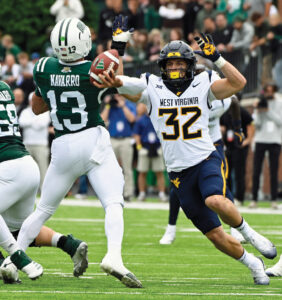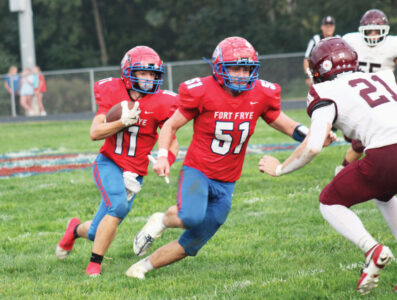Rich get richer with new college football alignment

Big 12 commissioner Brett Yormark attends Big 12 Media Days. (AP Photo)
MORGANTOWN — If power is money and money is power, just where does the new Big 12 rank in the new power structure of college athletics?
That really is an intriguing question.
With the impending demise of the Pac-12 as realignment picked its bones clean like a day-old Thanksgiving turkey and with realignment shuffling the deck so that conferences have crossed all territorial boundaries our conferences once had, what we’ve settled upon is really a power structure dominated by the SEC and the Big Ten.
There is no challenging that they are the National and American leagues of college sports while the Big 12 and the ACC are made up of the leftovers. They won’t like to be termed AAA franchises to the two power conferences, but it is hard to arrive at any other definition, at least in football.
With Oklahoma and Texas now residing in the SEC and USC and UCLA in the Big Ten, the balance of power has turned decidedly in those two conferences’ favor.
In June, 2023, the NCAA released the revenues generated by all D-1 colleges and it is quite revealing as to where the real money and power lies in college sports.
Of the Top 10 athletic department revenue schools, the SEC had seven schools and The Big Ten three schools.
That, as they say, is just the tip of the iceberg.
Those two conferences had 26 of the top 30 revenue schools and the other four were Virginia at No. 14, Florida State at No. 15, Clemson at No. 17 and Louisville at No. 23.
That’s four ACC schools.
Not one of the top 30 revenue schools, in fact, is from the Big 12 and the first school to show up on the list in Arizona at 31, followed by Arizona State at 33. Both those schools have yet to play a game in the Big 12.
In fact, the top revenue school left among the Big 12 schools last year now is Kansas. Followed by, yep, another Pac-12 refugee, Utah.
By the way, WVU doesn’t come onto the list until No. 45 with $105.2 million in total revenue.
Compare that to Ohio State, which ranked No. 1 in revenue with $251.6 million.
Interestingly, WVU competed quite well on the field in both football and basketball with the No. 2 school on list — Texas — which jumped to the SEC with $239.3 million in revenues. It expects to see a big jump in that figure.
Who are the Top Ten revenue schools?
You could probably name them, maybe in order, without looking:
No. 1 Ohio State, 2. Texas, 3. Alabama, 4. Michigan, 5. Georgia, 6. LSU, 7. Texas A&M, 8. Florida, 9. Penn State and 10. Oklahoma.
If you don’t believe this correlates into success, the NCAA’s own pre-season football top six teams are 1. Georgia, 2. Michigan, 3. Ohio State, 4. Alabama, 5. Penn State, 6. LSU.
That’s five of the top six revenue schools on the list with Penn State, which is No. 9 in revenue, at the No. 5 spot while Texas, which is second in revenue, a Top 20 team at No. 17.
In other words, in college football the rich get richer that figures to only magnify with the alignments.
One of the major problems with the new Big 12 obviously isn’t in a disparity in resources in members as there was when Oklahoma and Texas were in the conference, but that it lacks many of the great rivalries it once had, be it Oklahoma and Texas, Oklahoma and Oklahoma State, Texas and Texas A&M, Oklahoma and Nebraska, Missouri and Kansas and, while it wasn’t a Big 12 rivalry we will include WVU and Pitt and WVU and Virginia Tech.
There is a push to stress that new rivalries will be made, but that takes time. Think of how rich the history is over the Backyard Brawl and how important proximity of the schools is. Same goes for WVU and Virginia Tech, USC-USC, Cal-Stanford, Army-Navy, Texas-Oklahoma, Duke-North Carolina, Georgia-Florida, Alabama-Auburn.
Giving up those kinds of rivalries is a big sacrifice for the industry and it’s not something you can create by a slick PR campaign or my saying WVU and Cincinnati should be a rivalry.
This is what Alabama coach Nick Saban, himself a West Virginia native, said about this subject on Saturday:
“There’s a lot of traditions we’ve had for a long time in college football and I think we’re in a time of evolution for whatever reasons. And some of those traditions are going to get sort of pushed by the wayside, I think, and it’s sad.
“Whether good, bad or indifferent for college football, I guess you have to define what is good and bad for college football. So, I think one thing I would just hope that we would keep in mind in all the choices and decisions that we make relative to what we do in college athletics is the student-athlete.
“They’re here to get an education. We want to try and help them develop careers on and off the field, and hopefully some of the choices and decisions that we make for college athletics in the future will impact them in a positive way.
“And I hope we can keep that as a priority in terms of whatever we decide to do in the future of college football and college athletics.”





